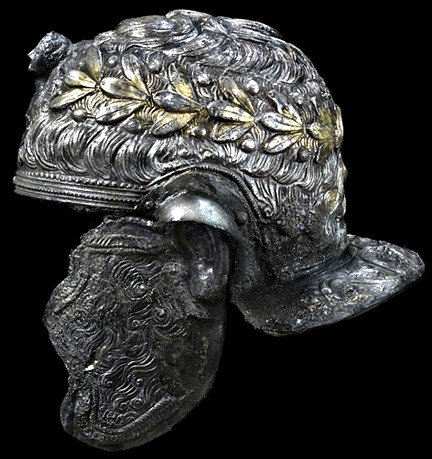Encuentran en casco romano restos de pegamento de hace 2.000 años
Foto: Glued With Care. The silver laurel leaves on this ancient Roman helmet were glued to the piece of armor with a fixative that has survived for thousands of years. Scientists studying the glue have found it was made of a mixture of bark and animal grease. Axel Thunker / Discovery News
El pegamento está compuesto por resina, betún y sebo de vaca, a los que probablemente les fue incorporado harina de ladrillo u hollín como sustancias minerales.
Científicos alemanes descubrieron en un casco romano los restos de un pegamento universal antiguo hasta ahora desconocido, comunicó hoy el museo regional de Renania.
El pegamento había sido utilizado para adherir a un casco de hierro de casi 2.000 años de antigüedad una fina capa de plata cincelada, explicó el restaurador Frank Willer.
El hallazgo fue hecho cuando intentaban retirar una minúscula prueba de material del casco con la ayuda de una sierra. El calor generado por la fricción hizo que se desprendiese la capa de plata y apareciesen entre ambos metales unos hilos misteriosos.
Por lo demás, la capacidad adherente seguía siendo completamente estable tras dos milenios, aseguró el experto en técnicas antiguas de fabricación.
El pegamento universal de los romanos está compuesto por resina, betún y sebo de vaca, a los que probablemente les fue incorporado harina de ladrillo u hollín como sustancias minerales, arrojaron los análisis.
Los especialistas de Bonn calificaron el hallazgo de "sensacional" argumentando que hasta ahora no hay ninguna mención de pegamentos en la literatura antigua.
Los arqueólogos conocen ya desde la era del hombre de Neandertal los pegamentos a base de resina, pero es la primera vez que encuentran un compuesto adhesivo orgánico entre dos metales.
Fuente: DPA / La Tercera.cl, 4 de diciembre de 2007
(2) Ancient Roman Glue Sticks Around
Roman warriors repaired their battle accessories with a superglue that is still sticking around after 2,000 years, according to new findings on display at the Rheinischen Landes Museum in Bonn, Germany.
Running until Feb. 16, 2008, the exhibition "Behind the Silver Mask" presents evidence that the ancient adhesive was used to mount silver laurel leaves on legionnaires' battle helmets.
"It's a sensational find and a complete stroke of luck that we were still able to find traces of the substance after 2000 years," Frank Willer, the museum's chief restorer, told Discovery News.
Willer found traces of the superglue while examining a helmet unearthed in 1986 near the German town of Xanten, on what was once the bed of the Rhine.
"The helmet, which dates from the 1st century B.C., was given to the museum for restoration. I discovered the glue accidentally, while removing a tiny sample of metal from the helmet with a fine saw. The heat from the tool caused the silver laurel leaves on the helmet to peel off, leaving thread-like traces of the glue behind," Willer said.
Willer was amazed to discover that despite such a long exposure to water, time and air, the superglue did not lose its bonding properties.
He said that other Roman battle accessories kept by the museum have traces of silver decorations which most likely had been glued to the iron with the same adhesive and technique. Unfortunately, the objects are too deteriorated to find traces of the superglue.
However, the helmet unearthed at Xanten featured enough material to determine how the adhesive was made.
"Analysis shows that the Roman glue was made of bitumen, bark pitch and animal grease," Willer said.
The finding confirms studies done by researchers at the University of Bradford and Liverpool, U.K., in the 1990s.
Analysis carried at that time on an ancient Roman jar showed that when Roman people broke their pots, they glued them back together with a compund "derived largely from birch bark."
So far, the German researchers have failed to recreate the Roman superglue.
"We think that some inorganic material such as soot, sand and quartz, might have been added to make the mixture stickier," Willer said.
Source: Rossella Lorenzi, Discovery News, Dec. 14, 2007

0 comentarios